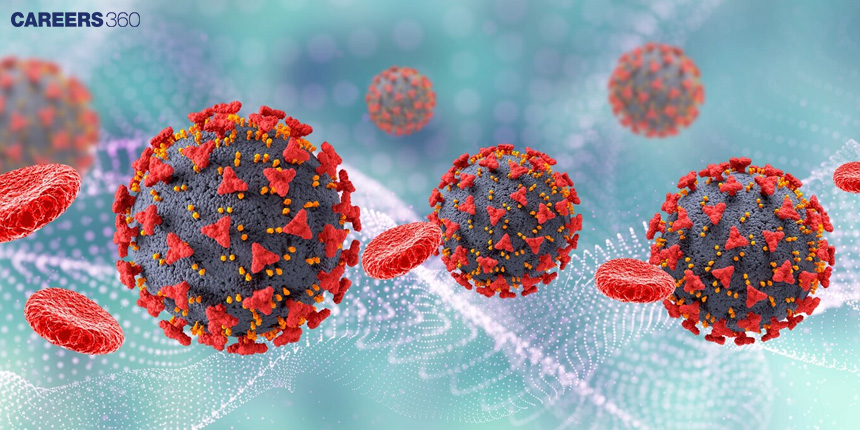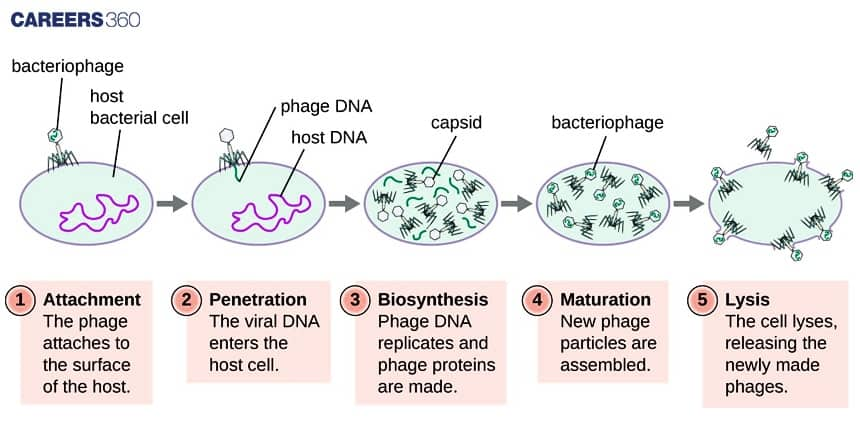Virology: Introduction, Diagram, Stages, Types, Life Cycle, FAQs
Virology is the branch of microbiology focused on the study of viruses and their interactions with hosts, including humans, animals, plants, and microorganisms. As a critical field in microbiology, virology examines the impact of viruses on health, the immune response, and methods for virus detection, prevention, and control. Being part of the Biological Classification chapter class 11th biology this becomes an important part examination syllabus in various exams. We'll be covering the basics of Virology, structure and types of viruses, and all the basics involved.
NEET 2025: Mock Test Series | Syllabus | High Scoring Topics | PYQs
NEET Important PYQ's Subject wise: Physics | Chemistry | Biology
New: Meet Careers360 B.Tech/NEET Experts in your City | Book your Seat now
- Introduction to Virology
- Structure and Classification of Viruses
- Classification of Viruses
- Types of Viruses
- Host-Virus Interactions
- Tips, Tricks, and Strategies for Virology

Introduction to Virology
Virology is the field of microbiology that deals with the study of viruses in structure, classification, genetics, and mechanisms of infection and replication in host organisms. The study of viruses is of great importance because they are the potential causes of a large number of diseases in human, animal, and plant organisms while playing such important roles in ecology and evolution. They are also helpful in the field of biotechnology.
The discovery of viruses dates back to the end of the 19th century with the discovery of the tobacco mosaic virus. Since then, several important breakthroughs, among them electron microscopy and molecular biology techniques, have propelled the field ahead.
Also Read:
Structure and Classification of Viruses
Viruses are made of a few structures which play a crucial role in infecting host cells and self-replication. The simple structure includes the capsid, the genetic material, and sometimes the outer envelope.
The capsid is the protein shell that covers and protects the genetic material of the virus. It is made of protein subunits known as capsomeres, and they have helical, icosahedral, or complex shapes. Some of the major points are discussed below :
It may also be single-stranded or double-stranded.
Some viruses possess an envelope, composed of a membrane of lipids from the host cellular membrane.
This envelope surrounds the capsid and often contains viral glycoproteins that contribute to attachment and entry into host cells.
The presence or absence of an envelope has a bearing on virus stability, infectivity, and transmission.
Classification of Viruses
They are classified based on many characteristics, including their viral genetic material, the presence or absence of the envelope, and a lot of other structural and functional properties.
DNA Viruses vs. RNA Viruses
DNA Viruses: These are viruses where their genetic material is represented by DNA. Examples are the ones of the Herpesviridae family, which causes herpes simplex and varicella-zoster and the Adenoviridae family, responsible for respiratory infections.
RNA Viruses: These include viruses with RNA as their genetic material. This grouping includes viruses of the Retroviridae family, which includes HIV, and the Orthomyxoviridae family, the causative agent of influenza.
Enveloped vs. Non-enveloped Viruses
Enveloped viruses have capsids enveloped by a lipid envelope originating from the host cell membrane and containing viral-derived glycoproteins. Examples of these include the families Herpesviridae and Retroviridae viruses.
Non-enveloped Viruses have no lipid envelope and thus are generally more resistant to environmental conditions. Examples include the family Picornaviridae, which includes poliovirus and rhinovirus and is the causative agent of the common cold, and the family Adenoviridae.
Types of Viruses
Viruses can also be classified based on the type of host they infect and transmission methods.
Animal Viruses infect animals, including humans. An example is the influenza virus, the rabies virus, and the coronavirus responsible for COVID-19.
Plant Viruses infect plants, leading to diseases that most generally affect crop yield and quality. Examples include the tobacco mosaic virus and the cucumber mosaic virus.
Bacteriophages, or phages, infect bacteria. Examples would include T4 phages that infect bacteria such as E. coli.
Retroviruses are RNA viruses that make use of reverse transcriptase, a single-stranded RNA that duplicates into DNA which then integrates into the genome of the host. One such famous retrovirus is HIV, which causes AIDS.
Arboviruses are transmitted by arthropod vectors, sometimes infecting both humans and animals. Diseases like dengue fever, Zika virus and West Nile virus are some of those caused by these viruses.
Diagram of the Viral Replication Cycle
The diagram given below shows the steps involved in the replication process of a virus.

Host-Virus Interactions
Various mechanisms, such as receptor-mediated endocytosis, direct fusion with the cell membrane, or directly injecting their genetic material into the host cell, mediate the entry of viruses into cells. Major events are mentioned below in the table:
Stages | Explanation |
Viral Entry |
|
Innate Immune Response |
|
Adaptive Immune Response |
|
Viral Immune Invasion |
|
Host-Virus Dynamics |
|
Tips, Tricks, and Strategies for Virology
It takes effort to remember everything in a single go. We made the entire problem easy. Some of the tricks regarding Virology are given below which you can use to memorise the important points.
Viral Entry Mechanisms
"RED: Receptor-Mediated, Endocytosis, Direct Fusion"
R: Receptor-Mediated – Viruses bind to specific receptors on the cell surface to enter.
E: Endocytosis – Viruses enter through vesicles formed by the cell membrane.
D: Direct Fusion – Some viruses fuse directly with the cell membrane to release genetic material.
Immune Response to Viral Infections
"IPT: Innate, Physical, T cells"
I: Innate Immunity – The body’s immediate, nonspecific response to infections.
P: Physical Barriers – Skin, mucous membranes, and phagocytic cells act as the first line of defence.
T: T cells and Antibodies – Adaptive immunity kicks in with T cells attacking infected cells and B cells producing antibodies.
Viral Immune Evasion
"HID: HIV, Influenza, Drifts"
H: HIV – Destroys CD4+ T cells, weakening the immune system.
I: Influenza – Uses antigenic shifts and drifts to evade antibody detection.
D: Drifts – Minor genetic changes in viral surface proteins to escape immune recognition.
Types of Viruses by Genetic Material
"DRA: DNA, RNA, Ambisense"
D: DNA Viruses – Use host replication machinery; more stable genome.
R: RNA Viruses – Mutate quickly due to lack of proofreading, leading to rapid evolution.
A: Ambisense Viruses – Contain both positive and negative-sense RNA strands.
Stages of Viral Replication
"AERAR: Attachment, Entry, Replication, Assembly, Release"
A: Attachment – Virus binds to host cell receptors.
E: Entry – The virus enters the cell via fusion or endocytosis.
R: Replication – Viral genome is copied using host cell machinery.
A: Assembly – New viral particles are formed.
R: Release – New viruses exit the host cell to infect others.
Read more:
Frequently Asked Questions (FAQs)
While viruses are smaller, non-living particles which can replicate only inside a host cell, bacteria are single-celled organisms which may grow and reproduce on their own.
Antiviral medications have their mode of action based on inhibition of specific viral enzymes or proteins integral to the virus lifecycle. In this case, reverse transcriptase or protease can be inducted.
Usual symptoms include fever, fatigue, sore throat, cough, runny nose, body aches, and in some cases, a rash or gastrointestinal problems.
Yes, some viruses do have the potential to interfere with normal mechanisms for controlling cell growth, and they are called oncogenic or oncogenic viruses. An example could be human papillomavirus, HPV, and Epstein-Barr virus, EBV.
Vaccines trigger the immune system to respond with an immune response against the viral antigens. Therefore, it will be helpful to the system in recognising and rapidly making an effective immune response to infection or decreasing its severity if infected with the actual virus.
Also Read
13 Nov'24 07:17 PM
13 Nov'24 05:08 PM
12 Nov'24 03:37 PM
12 Nov'24 01:07 PM
11 Nov'24 06:10 PM
10 Nov'24 07:48 PM
08 Nov'24 04:15 PM
06 Nov'24 08:32 AM
05 Nov'24 02:16 PM